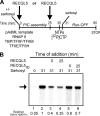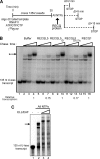Direct inhibition of RNA polymerase II transcription by RECQL5
- PMID: 19570979
- PMCID: PMC2749093
- DOI: 10.1074/jbc.M109.015750
Direct inhibition of RNA polymerase II transcription by RECQL5
Abstract
DNA helicases of the RECQ family are important for maintaining genome integrity, from bacteria to humans. Although progress has been made in understanding the biochemical role of some human RECQ helicases, that of RECQL5 remains elusive. We recently reported that RECQL5 interacts with RNA polymerase II (RNAPII), pointing to a role for the protein in transcription. Here, we show that RECQL5 inhibits both initiation and elongation in transcription assays reconstituted with highly purified general transcription factors and RNAPII. Such inhibition is not observed with the related, much more active RECQL1 helicase or with a version of RECQL5 that has normal helicase activity but is impaired in its ability to interact with RNAPII. Indeed, RECQL5 helicase activity is not required for inhibition. We discuss our findings in light of the fact that RECQ5(-/-) mice have elevated levels of DNA recombination and a higher incidence of cancer.
Figures






References
-
- Bachrati C. Z., Hickson I. D. (2008) Chromosoma 117,219–233 - PubMed
-
- Ellis N. A., Groden J., Ye T. Z., Straughen J., Lennon D. J., Ciocci S., Proytcheva M., German J. (1995) Cell 83,655–666 - PubMed
-
- Yu C. E., Oshima J., Fu Y. H., Wijsman E. M., Hisama F., Alisch R., Matthews S., Nakura J., Miki T., Ouais S., Martin G. M., Mulligan J., Schellenberg G. D. (1996) Science 272,258–262 - PubMed
-
- Kitao S., Lindor N. M., Shiratori M., Furuichi Y., Shimamoto A. (1999) Genomics 61,268–276 - PubMed
-
- Hickson I. D. (2003) Nat. Rev. Cancer 3,169–178 - PubMed
Publication types
MeSH terms
Substances
Grants and funding
LinkOut - more resources
Full Text Sources

